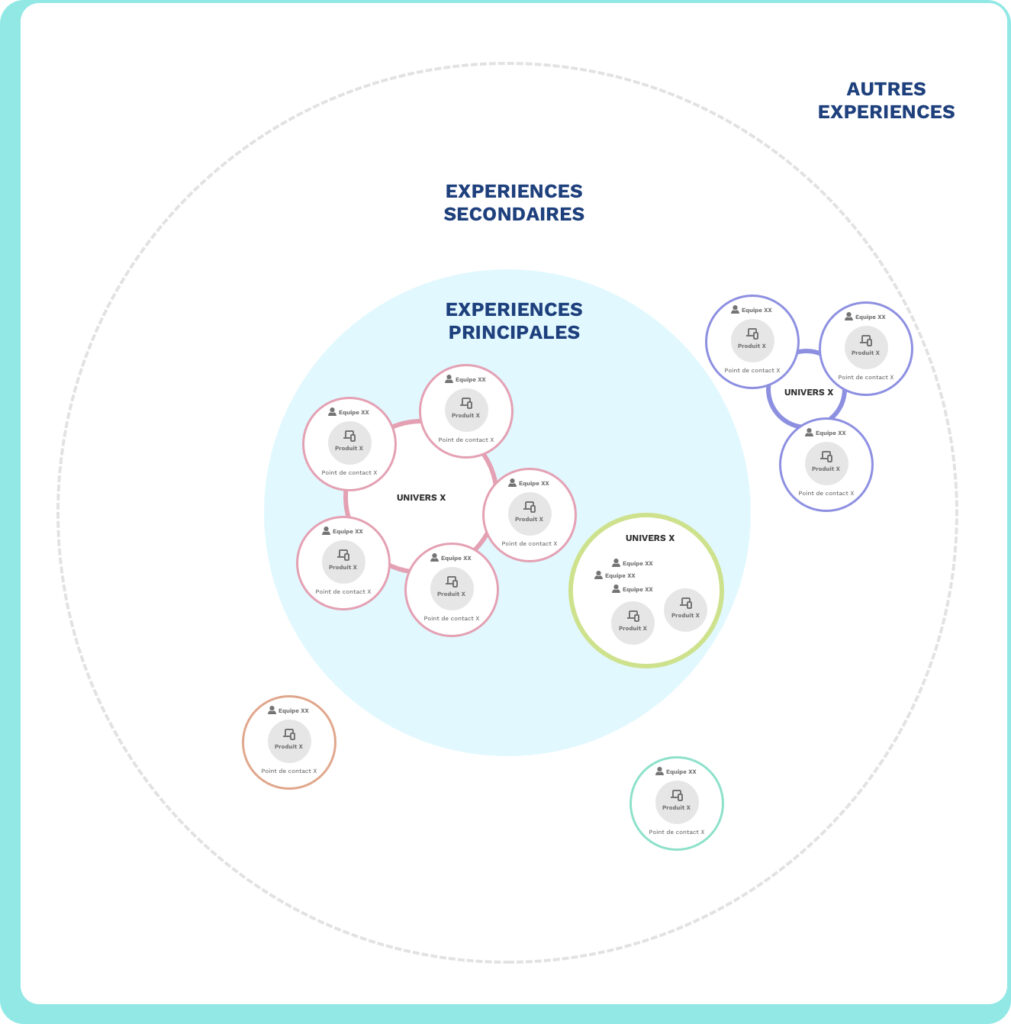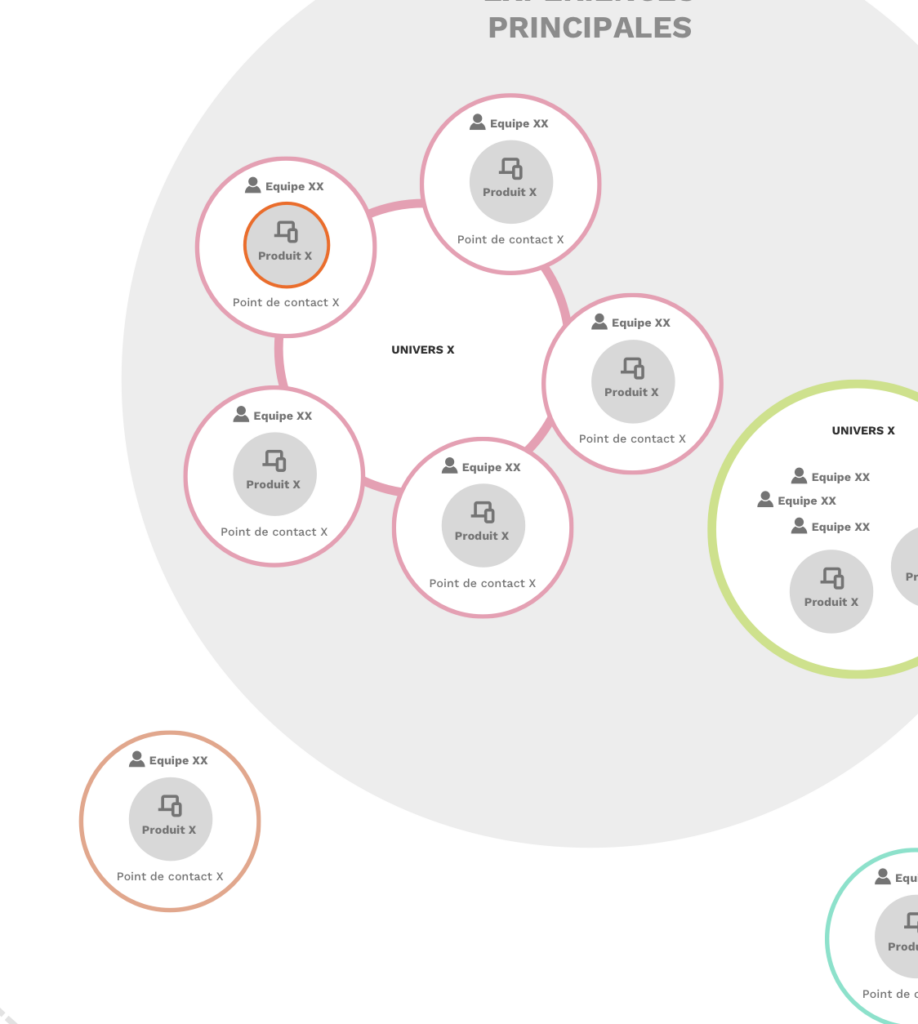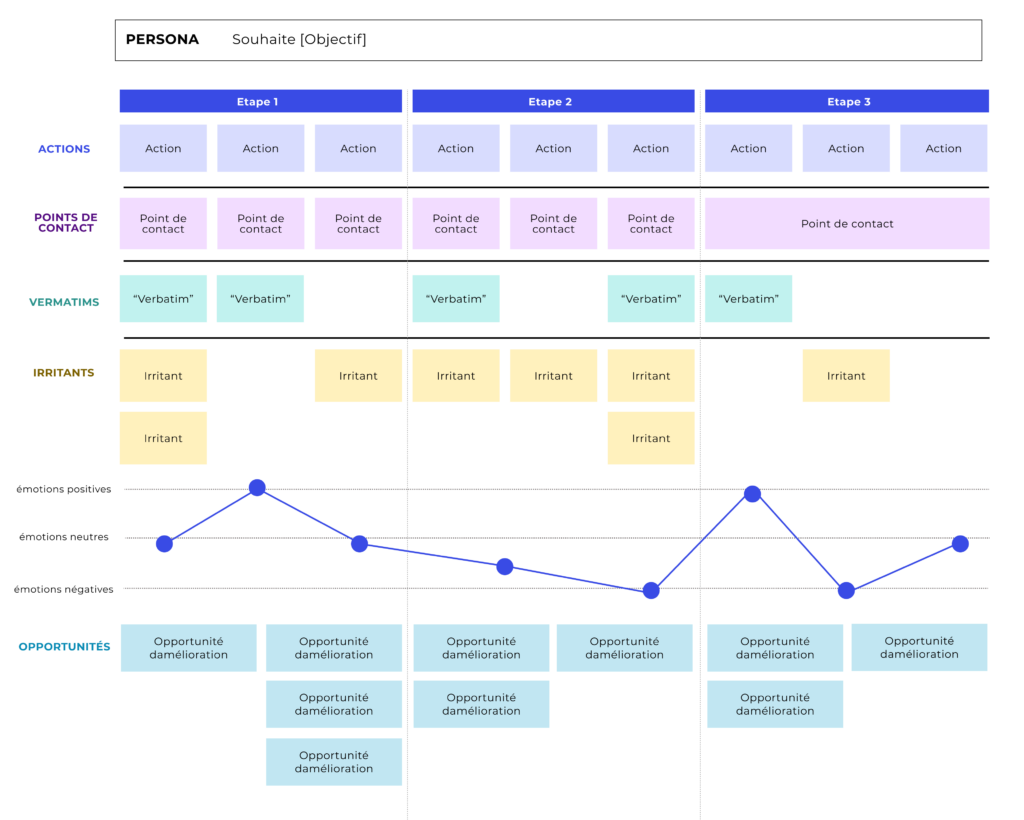Complex digital environments pose many challenges to teams, both in terms of understanding user issues and implementing solutions. In order to see more clearly, we offer two methods for mapping the user experience:
- The map ecosystem, which gives a vision of the products and actors that make up the user experience
- The journey map, which highlights the stages of the journeys and their friction points
Combined, these two levels of mapping will help you define your UX strategy and involve the right actors for its implementation.
I- ECOSYSTEM MAP:
What is a user-oriented map ecosystem?
The map we have built represents the digital ecosystem from a user point of view. The intention is to visualize the great experiences through the different touchpoints.
Unlike a more marketing and strategic oriented map, we crossed this user vision with a more organizational vision mapping the products as well as the teams intervening internally in a given structure.
model ecosystem map
Reading is done at two levels:
1- The macro vision of the digital ecosystem:
This first reading level aims to represent all of the access points offered to users. It is the visual representation of the brand's entire digital universe.
The contact points constitute a first level of reading. They are the entry points through which users arrive on a product/site (for example, directly through a search engine or specific URL).
It is also a question of highlighting all the stakeholders of a structure/brand involved in a specific product. This makes it possible to have a precise idea of which project team to refer to in the event that one intervenes on a particular subject and to understand the organization of the project teams (relative to the user experience)
2- The zoom by product or family of products:
In a second step, it is a question of going into a little more detail by focusing on the proposed experiences.
After identifying all the entry points, we aim to understand what type of product experience is offered and how the brand universe is structured. It is then that we can illustrate all the user experiences associated with each specific digital product. It is also possible to connect the project teams involved in the courses put forward. In addition, other data characterizing the product universes can complete the study, namely:
– List the issues in the field. To go further, you can even illustrate on a timeline the order of priorities relating to the issues.
– Underline the referents in charge in order to identify the heads of poles
– Add internal digital tools (for internal brand users)
Why use a map ecosystem?
This visual representation makes it possible to make observations on the digital environment that a brand offers to its users in terms of:
- Path: simple or complex (for example: offering a unified purchasing path on different digital products of the brand)
– Inventory of digital products offered by an entity. This makes it possible to understand the mesh as well as the relevance between each
– Organization of internal skill centers (siloed vs horizontal)
– Understand the digital universe of your company
All of these observations contribute to prioritizing the projects to be implemented in order to unify the courses and offer maximum consistency across all the products.
Zoom in in a map ecosystem
How to set up a map ecosystem?
Start by listing all the points of contact. Flattening the whole thing will allow you to have a first draft of the structure of the digital ecosystem. If possible, brainstorm with stakeholders having knowledge of the structure/projects and products in order to map a “draft” universe. As you know, it is always more constructive to iterate and discuss on the basis of a visual support that serves as a working basis.
Then, it is a question of going into the details of the "product poles" (in the case where your digital universe of the brand is very extensive...) in order to understand the type of experience offered, the intervening poles of competence, the digital products as well as understanding the issues.
Conduct interviews
Various interviews with key players were conducted in order to see more clearly and better understand the global organization of the digital universe. The ideal is to have direct access to the project managers of each pole in order to have their feelings on the construction of the map. This makes it possible to be part of a collaborative and transparent approach. Moreover, it is always appreciated to include all the parties in this project of representation of a common universe.
Points requiring special attention
When building an ecosystem map, you have to be vigilant on several points, namely:
- Identify the right people to interview to get relevant information specific to each “universe” or “pole”.
- Keep a synthetic spirit in the representation of cartography. We can't illustrate EVERYTHING! The idea is to keep this visualization of the proposed experiences in a summary format (especially in the global mapping)
A scalable tool
This representation is scalable and adapts to changes and organizations in the business world. The ideal is to share it with all the divisions so that they can transmit their adjustments continuously. This contributes to the desire for transparency and aligns the stakeholders with a level of cross-functional information.
In addition to the map ecosystem, which provides a global view of all user experiences, journey maps are ideal for drawing up a report on key user journeys.
II- JOURNEY MAP
What is a journey map?
The journey map allows you to map the route taken by the user when using your product (or service). It traces the user's actions and contact points during his journey, step by step. It also serves as a diagnostic tool for the journey by including the irritants encountered by the user and the opportunities for improvement. These “ups and downs” of the experience can be materialized on the map by an emotion curve and verbatims (we will then speak more of the experience map).
Why use a journey map?
There are two main types of journey maps that meet different needs:
- The journey map of the existing makes it possible to represent the current paths, to identify the irritants and to draw areas for improvement
- The target journey map describes the ideal journey desired for your user. It can be useful when designing a new experience, or reacting to an existing journey map.
Whether it represents the existing or a target vision, the journey map allows you to put yourself in the shoes of the users and better understand their actions, expectations and frustrations. It is also a very effective tool to convince stakeholders, because it illustrates in a very visual way the axes of improvement of an experience.
How to build a journey map?
- Define the persona and the scenario of the journey
The journey map is specific to the type of user and their objective. It is therefore essential to answer the following questions:
Which user do we represent ? Each family of users will have a different experience according to their expectations, needs, skills, etc. Build on your existing personas if you have any. If you don't have personas, I invite you to read this article and do the exercise.
Which scenario to cover ? Your product probably has several paths covering various needs. Focus on a key scenario to study, and write it down in the form of an objective that your user is trying to accomplish (e.g. Françoise, the online granny, wants to buy a cashmere sweater online to give to her little one -daughter Emma. She wishes to have it delivered to a relay point near Emma's.)
2. Collect the elements necessary for the development of the map
It's time to collect as much information as possible about users and their journeys. The journey map must be as faithful as possible to reality: avoid relying solely on assumptions and your intuition.
Several methods of user search make it possible to collect this information such as:
- Conducting interviews with users who match your persona
- Field observations
- User test results
- Tracking tools like Google Analytics…
3. Organize a journey mapping workshop
Ideally, the construction of the map is done as a team, in order to cross points of view and share a common vision. It is up to the facilitator to decide who should attend the workshop (developers, marketing, customer service, users etc.)
Before starting, the facilitator briefs the team on the objective of the workshop and shares a summary of the user research elements. Then the team fills in the canvas step by step, using post-its or a collaborative tool like Miro or Mural.
Here's a step-by-step guide to creating your map :
- Write your persona name and purpose at the top of the canvas
- List the actions performed by the user on post its
- Place the actions in the chronological order of the course
- Group actions into steps
- List touchpoints for each step
- List the irritants for each step
- Trace the curve of emotions with user experience highs and lows
- Complete the curve with verbatims (if you have any) and smileys
- Finally, analyze the irritants and turn them into something positive: opportunities for improvement. List these improvement points and place them at the bottom of the map, under the irritants
Model of a Journey Map (to be readjusted according to your needs)
There are several models of journey maps, it's up to you to define the one that best suits your needs. Do not hesitate to appropriate this deliverable and enrich it with what seems relevant to you.
Once this work is done, it is important to display the map in the team workspace, so that everyone can refer to it. The journey map is a living deliverable, which must evolve and be refined throughout the life of the product/service.
The final word
Combined, the map ecosystem and the journey map provide a global vision of the UX strategy to be implemented:
- On the "micro" level, the journey map makes it possible to define UX projects to be carried out in order to improve the user experience
- On the “macro” level, the ecosystem map helps to identify the products and the teams responsible for implementing the solutions, while taking into account the dependencies between the teams.
We recommend that you combine these two levels of reading during your release planning, making sure to:
- Create cross-product journey maps that take into account the overall user experience
- Prioritize improvement opportunities in terms of user value, business value and complexity
- Involve the various teams concerned in the search for solutions (and in their costing)
- Organize common release planning between teams to take into account dependencies and move forward on a common roadmap
We will of course continue to lead co-design workshops, whether between designers or with multidisciplinary teams. Knowing the concept of design by committee allows you to avoid errors, to reflect on the cohesion of your product, and to make the most of the results of our workshops.
Orane Lefevre & Meagan Rosengren – UX Designer @UX-Republic
Our next trainings
STORYTELLING: THE ART OF CONVINCING # Paris
SMILE Paris
163 quay of Doctor Dervaux 92600 Asnières-sur-Seine
UX/UI ECO-DESIGN # Paris
SMILE Paris
163 quay of Doctor Dervaux 92600 Asnières-sur-Seine
DESIGN THINKING: CREATING INNOVATION # Belgium
UX-REPUBLIC Belgium
12 avenue de Broqueville - 1150 Woluwe-Saint-Pierre
MANAGING AND MEASURING UX # Paris
SMILE Paris
163 quay of Doctor Dervaux 92600 Asnières-sur-Seine
DESIGN SPRINT: INITIATION & FACILITATION # Paris
SMILE Paris
163 quay of Doctor Dervaux 92600 Asnières-sur-Seine
UX-DESIGN: THE FUNDAMENTALS # Belgium
UX-REPUBLIC Belgium
12 avenue de Broqueville - 1150 Woluwe-Saint-Pierre
GOOGLE ANALYTICS 4 #Paris
SMILE Paris
163 quay of Doctor Dervaux 92600 Asnières-sur-Seine
ACCESSIBLE UX/UI DESIGN # Belgium
UX-REPUBLIC Belgium
12 avenue de Broqueville - 1150 Woluwe-Saint-Pierre















